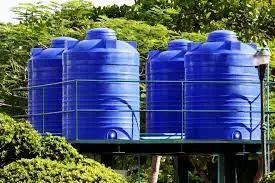
In a world increasingly crowded and polluted, water—a vital, priceless resource—has become ever more threatened. Once a symbol of purity, water has, in many places, turned into a source of concern and danger. Humans rely on water in nearly every detail of their lives: from drinking, which keeps them alive, to agriculture that produces their food, and even industry that drives their economy. Yet, many people fail to realize the extent of suffering endured by those who search for clean water within their own homes—especially those who rely on household water tanks for storage. Without proper care and treatment, these tanks can become breeding grounds for bacteria, parasites, and algae, turning them into a source of disease instead of a solution to water shortages.
Imagine waking up one day to find that the water you use for drinking, cooking, or washing your baby is contaminated with harmful substances invisible to the naked eye. This is not an exaggeration—it’s a daily reality for thousands of people in cities and villages alike, where drainage systems fail to protect them and authorities neglect their role in educating the public about the importance of water testing and treatment. Therefore, finding the best methods for treating tank water is no longer a luxury, but an urgent necessity to protect the health of individuals and families.
Treating water tanks is not just an environmental or health choice—it can be a matter of life or death. With increasing levels of contaminants such as E. coli, heavy metals, and chemicals from agriculture and industry, there is a pressing need for effective, proven methods to purify and disinfect water from anything that threatens human health. Seeking out the best ways to treat tank water is no longer a scientific privilege—it’s a plea from all who suffer in silence from the effects of contaminated water on their bodies, children, and futures.

Best Methods for Water Tank Treatment
The Importance of Water Tank Treatment
With growing environmental burdens and limited access to clean water resources, household water tanks have increasingly become the only viable option for meeting daily water needs. These tanks are used to store water for drinking, cooking, and cleaning, making them an integral part of family life. However, many people overlook the fact that these tanks can transform from a source of water security into a major health hazard if not properly maintained.
Over time, water tanks accumulate sediment, algae, and bacteria, particularly in hot regions or areas suffering frequent water outages. Without awareness about the importance of maintenance or with neglect of regular cleaning, stored water can become a perfect environment for harmful microbial growth. This can lead to health issues such as intestinal and skin diseases, and in some cases, chronic illnesses.
Neglecting water tank treatment exposes families to serious health risks—starting with foul odors and unpleasant taste, and potentially resulting in diseases among children and the elderly. Thus, treating tank water is not just a precaution; it is a health necessity that protects lives and the future of the community.
Best Methods for Water Tank Treatment
-
Regular Tank Cleaning
Routine cleaning is one of the most important preventive measures to ensure water purity. Accumulated algae and dirt inside tanks increase the likelihood of bacteria and fungi growth. Cleaning should be done using safe, non-toxic tools, with attention given to removing deposits from tank walls, especially in corners and lower areas. It’s recommended to clean the tank at least once every six months to maintain water quality. -
Chlorination
Chlorine is one of the most common and effective water disinfectants, capable of eliminating harmful bacteria and germs. However, it must be used in calculated doses based on tank size and contamination type to avoid health side effects. In cases of uncertainty, it’s advisable to seek assistance from professionals or reputable companies like “Aqua Tech” or local services in areas such as Khamis Mushait. -
Ultraviolet (UV) Treatment
UV technology is a modern and safe method for water disinfection. It works by destroying the DNA of microorganisms without using chemicals, making it ideal for regularly refilled tanks. It ensures water remains pure every time the tank is filled. -
Ozone Treatment
Ozone is one of the most powerful natural disinfectants due to its high oxidation ability, making it effective against bacteria, viruses, and even some heavy metals. It leaves no residue or taste, making it a preferred option for residential and commercial facilities. However, it requires professional supervision to ensure the safe use of ozone generators and correct dosing. -
Bio-Membrane Filtration
Bio-membrane technology is one of the most advanced methods for water purification. It uses fine filters made from biological materials to remove microscopic particles and chemicals. Though relatively costly, it is ideal for locations requiring high purity levels, such as hospitals and healthcare facilities.
Conclusion
With rising water pollution levels and related health issues, relying on seasonal cleaning or random measures is no longer sufficient. Scientifically sound, consistent approaches to water tank treatment are now essential. Whether through physical cleaning, chemical disinfection, or advanced technologies like UV or ozone, selecting the appropriate method depends on water usage and quality.
Water tank treatment is a collective responsibility—from individuals to the entire community. It is a preventive step toward building a healthy environment, ensuring safer living, and securing a future free from waterborne diseases.
Effective Tips for Maintaining Water Tank Quality
Given the increasing environmental challenges and pollution levels, one-time treatment of tank water is not enough. Ongoing preventive actions are necessary to ensure the water remains safe for use. Clean water doesn’t happen by chance—it is the result of awareness and consistent behavior. Here are practical tips that can make a real difference in stored water quality and help protect public health:
-
Proper Tank Covering
A secure tank lid is the first defense against water contamination. It should be intact and free of even small cracks or holes that could let in dust, insects, debris, or rodents. A loose cover not only allows pollutants in but also fosters algae growth and bad odors. Specially designed weather-resistant lids offer maximum protection. -
Regular Maintenance
Like any facility, water tanks require periodic maintenance to ensure their functionality and integrity. A thorough inspection every 3–6 months can reveal early signs of leaks or cracks, particularly in concrete or plastic tanks prone to wear. Maintenance also includes checking valves, filters, and connecting pipes. It preserves water quality and extends the tank’s lifespan, preventing costly breakdowns. -
Proper Water Storage
A common mistake is storing large amounts of water for long periods without use. Stagnant water promotes algae and anaerobic bacteria growth, especially in hot climates. To avoid this, use stored water regularly and avoid stockpiling more than needed. If large storage is unavoidable, consider using safe antibacterial agents or water circulation systems to prevent stagnation. -
Consulting Experts When Needed
Sometimes, visual indicators like color or odor changes are not enough to detect contamination. Consulting water treatment experts becomes vital, as some pollutants—whether bacterial or chemical—require precise lab analysis. Expert guidance is a wise investment in family health, offering tailored recommendations based on tank type, water nature, and optimal treatment methods.
Importance of Implementing These Tips
-
Proper Tank Covering
Secure tank lids prevent entry of dirt, insects, rodents, and sunlight—all factors that encourage algae growth. Neglecting this step leads to contamination with organic and inorganic matter, altering water color and odor, and encouraging germ proliferation. -
Regular Maintenance
Tanks must be inspected and maintained to detect wall cracks, pipe malfunctions, or valve defects. Maintenance preserves internal tank structure and prevents leaks or contamination. Ignoring it can lead to water seepage, fungal growth, and chemical reactions causing pollution. -
Proper Water Storage
Improper water storage—keeping water for long periods without movement—leads to stagnation and encourages algae and harmful bacteria, especially in hot areas. Regular use and right-sizing storage volumes help maintain water quality. -
Consulting Experts
In complex contamination cases, expert analysis is vital. Continuing to use suspicious water without lab testing or professional advice can cause severe health risks, especially to children and the elderly.
Final Thoughts
Prevention is always better than cure, especially when it comes to a vital resource like water. Maintaining tank water quality goes beyond treatment—it involves simple but effective preventive steps that stop contamination before it starts. Applying these tips regularly ensures clean, safe water for your family and reduces reliance on emergency interventions or tank replacement.
Remember: every drop of clean water is a building block in protecting human health and preserving our environment.